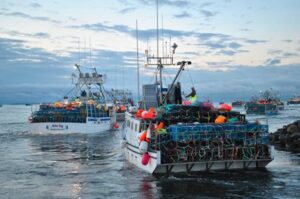Tag Archives: The “Blob”
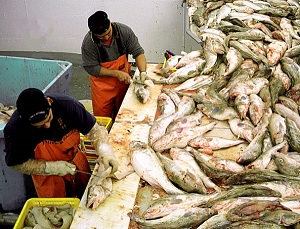
Stock decline leads to historic shutdown for Gulf P-cod
Gulf of Alaska Pacific cod fishermen will be keeping their gear dry this winter: The federal fishery has been closed for the 2020 season. The North Pacific Fishery Management Council decided to close the fishery due to concerns about historic low biomass shown in the latest stock assessment. The struggles of the stock have been linked to climate change more than excessive fishing. In 2014, the Gulf of Alaska experienced a major influx of warm water, linked to the El Nino event in the south Pacific. >click to read< 15:44

International expedition answers troubling questions about B.C. salmon runs
Buried in the doom-and-gloom headlines about depleted salmon stocks and disastrous spawning returns is this nugget of truth: There are more salmon in the Pacific Ocean than at any time since 1925.,,, The Russian research vessel Kaganovsky set out on a five-week grid-search test fishery in the North Pacific last February with a team of 21 scientists from Canada, Russia, the United States, Korea and Japan. They examined specific questions about the range, feeding habits and condition of adult salmon, and at least some of the answers are trickling in. >click to read< 15:51

Oregon researchers investigate latest marine heatwave that could hurt Pacific ecosystems
Earlier this month, the feds announced there was trouble brewing in the Pacific: a mass of warm water was building off the west coast, reminiscent of another event nicknamed “The Blob,” which caused havoc for wildlife and fishermen just a few years ago. Experts caution that the current marine heatwave is still in its infancy and could dissipate today, tomorrow or next week.,,, “This marine heatwave took shape in June, persisted, and has grown in size,” said Chris Harvey, a research biologist at the Northwest Fishery Science Center, >click to read< 17:54

California coasts recovering, but more marine heatwaves like ‘The Blob’ expected
The effects of the marine heatwave off the California coast from 2014 to 2016, better known as The Blob, that led to a decrease in Chinook salmon and virtually shut down the Dungeness crab industry are finally starting to wear off.,,, “It wasn’t about (a lack of) abundance,” said Noah Oppenheim, executive director of the Pacific Coast Federation of Fishermen’s Associations. “It was about destabilized ecosystems.” >click to read< 10:50

The Legacy of the Blob
In 2013, a mass of unusually warm water appeared in the Gulf of Alaska. Over the next three years, the Blob, as it became known, spread more than 3,200 kilometers, reaching down to Mexico. This freak marine heatwave, combined with a strong El Niño, drastically affected the Pacific Ocean ecosystem killing thousands of animals and changing the distribution of species along the coast. It’s been three years since the Blob dissipated, and researchers are taking stock of its long-term impacts on fish and other wildlife. >click to read< 08:41

Cooling California Current could mean good news for fisheries, ecosystems
Ocean currents off the Northern California coast are cooling down — potentially good news for the region’s fisheries and ecosystems, battered in recent years by warm currents that have triggered a range of disruptions, from faltering salmon runs to a devastated kelp forest and abalone populations. In a report on the California Current, NOAA scientists last week said that cooler water has resulted in improved condition of zooplankton – the foundation of the ocean’s food chain – greater juvenile salmon returns, and bigger anchovy schools, a boon to larger fish and whales. On the other hand, scientists said,,, >click to read<20:24

Value of Bristol Bay salmon rises, even as the fish shrink
Bristol Bay’s strong salmon returns stand in stark contrast to other parts of Alaska where the fish have trickled in slowly or seemingly not at all. Statewide, though, fish of all species are coming in smaller. Here’s why. 2018 has been a year for the Bristol Bay record books as total sockeye run surpassed 61 million on Thursday, putting it just a half-million fish behind the largest run of 61.7 million in 1980. Bert Lewis oversees commercial fisheries in Bristol Bay, Cook Inlet and Prince William Sound for the Alaska Department of Fish and Game. He’s impressed at the strength of the Nushagak district’s run and even at Bristol Bay’s east-side districts, which came in “late but solidly.”>click to read<10:46

North Pacific Recovering From The Blob, Salmon More Slowly
Ocean conditions off most of the U.S. West Coast are returning roughly to average, after an extreme marine heat wave from about 2014 to 2016 disrupted the California Current Ecosystem and shifted many species beyond their traditional range, according to a new reportfrom NOAA Fisheries’ two marine laboratories on the West Coast. Some warm waters remain off the Pacific Northwest, however. >click to read<07:57

Ghost of ‘the Blob’ haunts Pacific salmon
The initial period after ocean entry for Columbia River basin juvenile salmon and steelhead is when most of the mortality occurs during their lives at sea, so ocean conditions — temperatures and nutrient supplies — during that period are critical to how many of the fish will return to the river as adults one to three years later. The path the fish take after they enter the ocean makes a difference, according Laurie Weitkamp of NOAA Fisheries’ Northwest Fisheries Science Center, Newport Field Station, especially lately with the “strange” ocean conditions. >click here to read< 10:31
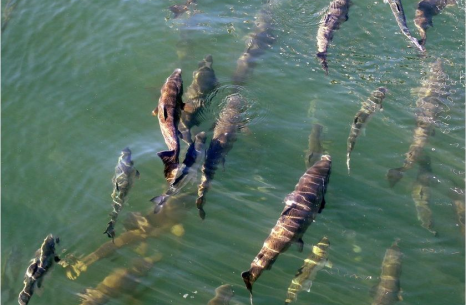
The “blob” is gone, but it’s left a troubling legacy on B.C.’s Pacific coast.
The blob is the popular name for a huge patch of warm water that featured record temperatures — in some cases, three to four degrees Celsius above normal — in the Northeast Pacific starting in 2013 and running through late 2015 and early 2016. Scientists are now concerned that young fish feeding at sea during the blob’s presence did not have enough nutritious food to eat — and that could translate into reduced adult fish to harvest going forward. click here to read the story 08:07

Pacific Ocean ‘blob’ appears to take toll on Alaska cod
Gulf of Alaska cod populations appear to have nose-dived, a collapse fishery scientists believe is linked to warm water temperatures known as “the blob” that peaked in 2015. The decline is expected to substantially reduce the Gulf cod harvests that in recent years have been worth — before processing — more than $50 million to Northwest and Alaska fishermen who catch them with nets, pot traps and baited hooks set along the sea bottom.,,, Scientists don’t ascribe the blob specifically to climate change. Gulf of Alaska temperatures — influenced by atmospheric conditions such as wind strengths — have always fluctuated over time. But researchers have never before tracked such an extreme heat wave that spread across such distances and penetrated to such depths. click here to read the story 11:52
Mystery of world’s worst toxic algal blooms solved: Cold water upswells from the deeper ocean
 The most deadly algal blooms have extremely high levels of the neurotoxin domoic acid, which causes paralytic food poisoning and in rare cases amnesia or death if people eat contaminated shellfish. Scientists now think they have discovered why such blooms happen. It was previously thought that a pocket of warm water, known as a ‘warm blob’, was to blame. A study in Geophysical Research Letters has now identified that in fact upwelling of cold water from the deep oceans was responsible. click here to read the story 09:31
The most deadly algal blooms have extremely high levels of the neurotoxin domoic acid, which causes paralytic food poisoning and in rare cases amnesia or death if people eat contaminated shellfish. Scientists now think they have discovered why such blooms happen. It was previously thought that a pocket of warm water, known as a ‘warm blob’, was to blame. A study in Geophysical Research Letters has now identified that in fact upwelling of cold water from the deep oceans was responsible. click here to read the story 09:31
Bad salmon run hints at trouble ahead
 Count backward three years and we come to 2014 — precursor to this spring’s extremely poor salmon returns. Fewer than 20,000 adult spring Chinook and about 1,500 immature jacks have been counted at Bonneville Dam, compared to 10-year averages of about 127,000 and 17,000. Shad, another species that should begin surging toward inland spawning grounds about now, reached a count of 26 at Bonneville late last week, compared to the 10-year average of more than 11,000. In the case of Chinook, actual returns may not be quite so bleak as the dam count indicates. Heavy mountain runoff has made the Columbia’s water cloudy and cold. Test fisheries found quite a few Chinook loitering here in the estuary, delaying their swim upstream. But with the start of summer only a month away, there isn’t much time left for the spring run to come through. If they don’t make it to spawning grounds, the run three years from now also will be weak. click here to read the op-ed 09:36
Count backward three years and we come to 2014 — precursor to this spring’s extremely poor salmon returns. Fewer than 20,000 adult spring Chinook and about 1,500 immature jacks have been counted at Bonneville Dam, compared to 10-year averages of about 127,000 and 17,000. Shad, another species that should begin surging toward inland spawning grounds about now, reached a count of 26 at Bonneville late last week, compared to the 10-year average of more than 11,000. In the case of Chinook, actual returns may not be quite so bleak as the dam count indicates. Heavy mountain runoff has made the Columbia’s water cloudy and cold. Test fisheries found quite a few Chinook loitering here in the estuary, delaying their swim upstream. But with the start of summer only a month away, there isn’t much time left for the spring run to come through. If they don’t make it to spawning grounds, the run three years from now also will be weak. click here to read the op-ed 09:36
Year in Review: Ocean changes upend North Coast fisheries
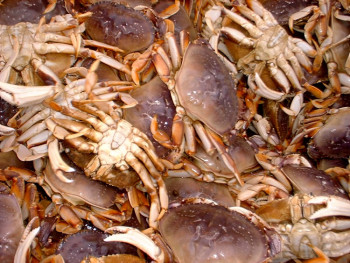 In any other year, the large bins of Dungeness crab that are loaded dockside in this busy fishing village and rolled out by truck to be sold and served during the holidays would seem like no big deal. But after an unprecedented delay in the 2015-16 commercial season forced local crabbers to leave their boats tied up through winter and on into spring, the tons of meaty crustaceans landed in port this month have been a welcome sign of normalcy restored, if only for a moment. For here on the edge of the Pacific, where commercial fishing remains a way of life, once reliable ocean rhythms have been seriously unsettled of late, confounding those who depend on predictable, seasonal cycles and highlighting future uncertainties. Even the current Dungeness season lurched off to a bumpy start, with the fishery opening piecemeal and mostly behind schedule, a symptom of widespread marine anomalies that have prevailed for the past three years, threatening everything from seabirds and sea lions to treasured catches such as salmon and abalone. Read the story here 10:04
In any other year, the large bins of Dungeness crab that are loaded dockside in this busy fishing village and rolled out by truck to be sold and served during the holidays would seem like no big deal. But after an unprecedented delay in the 2015-16 commercial season forced local crabbers to leave their boats tied up through winter and on into spring, the tons of meaty crustaceans landed in port this month have been a welcome sign of normalcy restored, if only for a moment. For here on the edge of the Pacific, where commercial fishing remains a way of life, once reliable ocean rhythms have been seriously unsettled of late, confounding those who depend on predictable, seasonal cycles and highlighting future uncertainties. Even the current Dungeness season lurched off to a bumpy start, with the fishery opening piecemeal and mostly behind schedule, a symptom of widespread marine anomalies that have prevailed for the past three years, threatening everything from seabirds and sea lions to treasured catches such as salmon and abalone. Read the story here 10:04
Poor Ocean Conditions Hit West Coast Fisheries Hard
 United States commercial fisheries are doing fine overall, but fishermen on the West Coast are hurting. An 2015 annual report out Wednesday from the National Oceanic and Atmospheric Administration shows a stark fall-off in the big seafood money-makers in the Pacific Northwest. Nationally, 2015 was an above average year in terms of catch rate, commercial value and national seafood consumption. “On dinner plates, the average American added nearly an extra pound of seafood,” said Richard Merrick, Chief Scientists of NOAA Fisheries during a call with reporters. But this rise in consumption didn’t really help the Oregon and Washington fishing industry because the crab and fish weren’t there to catch. NOAA Fisheries scientists are attributing the low West Coast returns to abnormal conditions in the Pacific that are linked to climate change. Read the story here 19:11
United States commercial fisheries are doing fine overall, but fishermen on the West Coast are hurting. An 2015 annual report out Wednesday from the National Oceanic and Atmospheric Administration shows a stark fall-off in the big seafood money-makers in the Pacific Northwest. Nationally, 2015 was an above average year in terms of catch rate, commercial value and national seafood consumption. “On dinner plates, the average American added nearly an extra pound of seafood,” said Richard Merrick, Chief Scientists of NOAA Fisheries during a call with reporters. But this rise in consumption didn’t really help the Oregon and Washington fishing industry because the crab and fish weren’t there to catch. NOAA Fisheries scientists are attributing the low West Coast returns to abnormal conditions in the Pacific that are linked to climate change. Read the story here 19:11
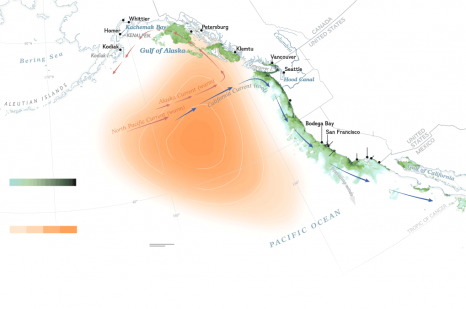
The Blob That Cooked the Pacific
Beginning in late 2013, a bewildering patch of warm water formed in the Gulf of Alaska. A stubborn atmospheric high-pressure system, nicknamed the “Ridiculously Resilient Ridge,” was keeping storms at bay. Just as blowing across hot coffee frees heat, winds usually churn and cool the sea’s surface. Instead, heat within this shifting mass, which University of Washington climatologist Nick Bond dubbed “the blob,” built up and morphed into a wider patch along North America’s West Coast, where it met warm-water masses creeping north. Sea temperatures in some places rose seven degrees Fahrenheit higher than average. Some patches of ocean were hotter than ever recorded. At its peak the warm water covered about 3.5 million square miles from Mexico to Alaska, an area larger than the contiguous United States. Read the story here 10:40
Marine ecosystems still at risk as ‘the blob’ sinks deeper below the surface, says DFO
 The giant ocean ‘blob’ isn’t dead — yet. The warm patch of water that stretches along the Pacific Coast is currently resting several hundred metres below the surface of the ocean, despite earlier reports that it had dissipated, according to new data. “What we’re finding is that the upper waters are being mixed by the wind again and coming back to normal temperatures, but the residual effect of the blob is still there at about 150 to 200 metres [below the surface],” said Ian Perry, a senior research scientist with Fisheries and Oceans Canada. The blob was widely pronounced dead earlier this year after satellite heat images no longer detected abnormally warm waters on the surface of the Pacific Coast. However, the imaging only read up to 40 metres below the surface, said Perry. Read the story here 11:31
The giant ocean ‘blob’ isn’t dead — yet. The warm patch of water that stretches along the Pacific Coast is currently resting several hundred metres below the surface of the ocean, despite earlier reports that it had dissipated, according to new data. “What we’re finding is that the upper waters are being mixed by the wind again and coming back to normal temperatures, but the residual effect of the blob is still there at about 150 to 200 metres [below the surface],” said Ian Perry, a senior research scientist with Fisheries and Oceans Canada. The blob was widely pronounced dead earlier this year after satellite heat images no longer detected abnormally warm waters on the surface of the Pacific Coast. However, the imaging only read up to 40 metres below the surface, said Perry. Read the story here 11:31
Another “blob” of warm ocean water discovered, this one ancient
 While the Pacific “blob” seems to have died, this new research say they can find blobs lost in time. What is most interesting is that they say Greenland went through temperature shifts of 10-15 degrees C in just 50 years, all without any man-made influence. New research published in Scientific Reports in February indicates that a warm ocean surface water prevailed during the last ice age, sandwiched between two major ice sheets just south of Greenland. Read the rest here 09:51
While the Pacific “blob” seems to have died, this new research say they can find blobs lost in time. What is most interesting is that they say Greenland went through temperature shifts of 10-15 degrees C in just 50 years, all without any man-made influence. New research published in Scientific Reports in February indicates that a warm ocean surface water prevailed during the last ice age, sandwiched between two major ice sheets just south of Greenland. Read the rest here 09:51
Salmon ‘nightmare’ ahead?
 Oregon and Washington will experience two big El Nino-like events in combination this year, scientists and fishery managers say. This has never happened before and the events could have major impacts on commercial and recreational fisheries — and ocean species from salmon to orcas — for years to come. One of these events is a true El Nino — a big one — and brings with it the likelihood of less precipitation and warmer temperatures in the Pacific Northwest. The other event, the “Blob,” is a warm expanse of water that has persisted off the West Coast for over a year and only resembles El Nino. It is an anomaly, a mystery. Read the rest here 19:59
Oregon and Washington will experience two big El Nino-like events in combination this year, scientists and fishery managers say. This has never happened before and the events could have major impacts on commercial and recreational fisheries — and ocean species from salmon to orcas — for years to come. One of these events is a true El Nino — a big one — and brings with it the likelihood of less precipitation and warmer temperatures in the Pacific Northwest. The other event, the “Blob,” is a warm expanse of water that has persisted off the West Coast for over a year and only resembles El Nino. It is an anomaly, a mystery. Read the rest here 19:59
Ocean blob brings tropical fish to B.C. coast
 Something unusual is happening off the coast of British Columbia. Fish species normally found in the warm waters of the tropics are finding their way north — and a blob is being blamed. Ian Perry, a research scientist with the Department of Fisheries and Oceans based on Vancouver Island, says butterfish, tope sharks, ocean sunfish, even a finescale triggerfish have all been spotted further north than usual. Perry says it’s not uncommon for some of these fish to find their way northward every five to 10 years, whenever there’s an El Nino, a massive patch of warm water that appears in the Equatorial Pacific every few years. Read the rest here 09:51
Something unusual is happening off the coast of British Columbia. Fish species normally found in the warm waters of the tropics are finding their way north — and a blob is being blamed. Ian Perry, a research scientist with the Department of Fisheries and Oceans based on Vancouver Island, says butterfish, tope sharks, ocean sunfish, even a finescale triggerfish have all been spotted further north than usual. Perry says it’s not uncommon for some of these fish to find their way northward every five to 10 years, whenever there’s an El Nino, a massive patch of warm water that appears in the Equatorial Pacific every few years. Read the rest here 09:51








































